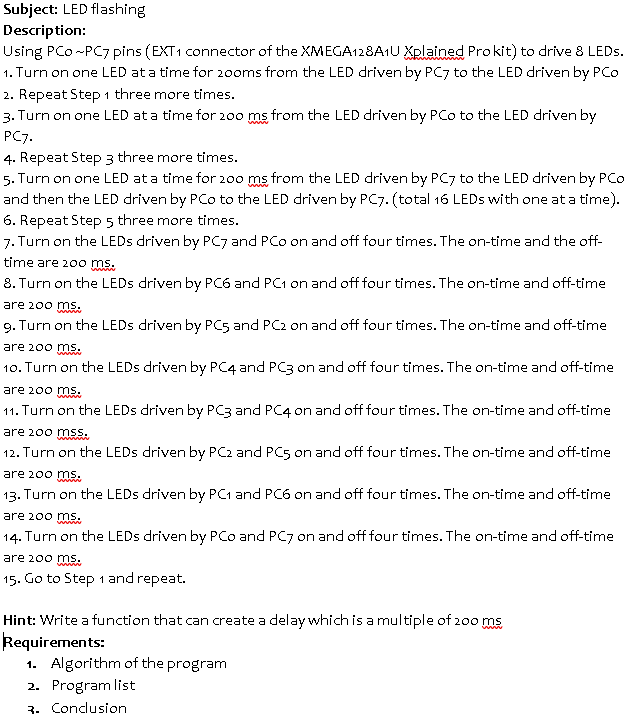Answered step by step
Verified Expert Solution
Question
1 Approved Answer
Programming Language: AVR Assembly Language Subject: LED flashing Description: Using PCo-PC7 pins (EXT1 connector of the XMEGA128A10 Xplained Prokit) to drive 8 LEDs. 1. Turn

Programming Language: AVR Assembly Language
Subject: LED flashing Description: Using PCo-PC7 pins (EXT1 connector of the XMEGA128A10 Xplained Prokit) to drive 8 LEDs. 1. Turn on one LED at a time for zooms from the LED driven by PC7 to the LED driven by PCO 2. Repeat Step 1 three more times. 3. Turn on one LED at a time for 200 ms from the LED driven by PCo to the LED driven by PC7. 4. Repeat Step 3 three more times. 5. Turn on one LED at a time for 200 ms from the LED driven by PC7 to the LED driven by PCO and then the LED driven by PCo to the LED driven by PG7. (total 16 LEDs with one at a time). 6. Repeat Step 5 three more times. 7. Turn on the LEDs driven by PG7 and PCo on and off four times. The on-time and the off- time are 200 ms. 8. Turn on the LEDs driven by PC6 and PG1 on and off four times. The on-time and off-time are 200 ms. 9. Turn on the LEDs driven by PCs and PC2 on and off four times. The on-time and off-time are 200 ms. 10. Turn on the LEDs driven by PC4 and PC3 on and off four times. The on-time and off-time are 200 ms. 11. Turn on the LEDs driven by PC3 and PC4 on and off four times. The on-time and off-time are 200 mss. WWW 12. Turn on the LEDs driven by PG2 and PCs on and off four times. The on-time and off-time are 200 ms. 13. Turn on the LEDs driven by PC1 and PC6 on and off four times. The on-time and off-time are 200 ms. 14. Turn on the LEDs driven by PCo and PC7 on and off four times. The on-time and off-time are 200 ms. 15. Go to Step 1 and repeat. Hint: Write a function that can create a delay which is a multiple of 200 ms Requirements: 1. Algorithm of the program 2. Program list 3. Conclusion Subject: LED flashing Description: Using PCo-PC7 pins (EXT1 connector of the XMEGA128A10 Xplained Prokit) to drive 8 LEDs. 1. Turn on one LED at a time for zooms from the LED driven by PC7 to the LED driven by PCO 2. Repeat Step 1 three more times. 3. Turn on one LED at a time for 200 ms from the LED driven by PCo to the LED driven by PC7. 4. Repeat Step 3 three more times. 5. Turn on one LED at a time for 200 ms from the LED driven by PC7 to the LED driven by PCO and then the LED driven by PCo to the LED driven by PG7. (total 16 LEDs with one at a time). 6. Repeat Step 5 three more times. 7. Turn on the LEDs driven by PG7 and PCo on and off four times. The on-time and the off- time are 200 ms. 8. Turn on the LEDs driven by PC6 and PG1 on and off four times. The on-time and off-time are 200 ms. 9. Turn on the LEDs driven by PCs and PC2 on and off four times. The on-time and off-time are 200 ms. 10. Turn on the LEDs driven by PC4 and PC3 on and off four times. The on-time and off-time are 200 ms. 11. Turn on the LEDs driven by PC3 and PC4 on and off four times. The on-time and off-time are 200 mss. WWW 12. Turn on the LEDs driven by PG2 and PCs on and off four times. The on-time and off-time are 200 ms. 13. Turn on the LEDs driven by PC1 and PC6 on and off four times. The on-time and off-time are 200 ms. 14. Turn on the LEDs driven by PCo and PC7 on and off four times. The on-time and off-time are 200 ms. 15. Go to Step 1 and repeat. Hint: Write a function that can create a delay which is a multiple of 200 ms Requirements: 1. Algorithm of the program 2. Program list 3. ConclusionStep by Step Solution
There are 3 Steps involved in it
Step: 1

Get Instant Access to Expert-Tailored Solutions
See step-by-step solutions with expert insights and AI powered tools for academic success
Step: 2

Step: 3

Ace Your Homework with AI
Get the answers you need in no time with our AI-driven, step-by-step assistance
Get Started


